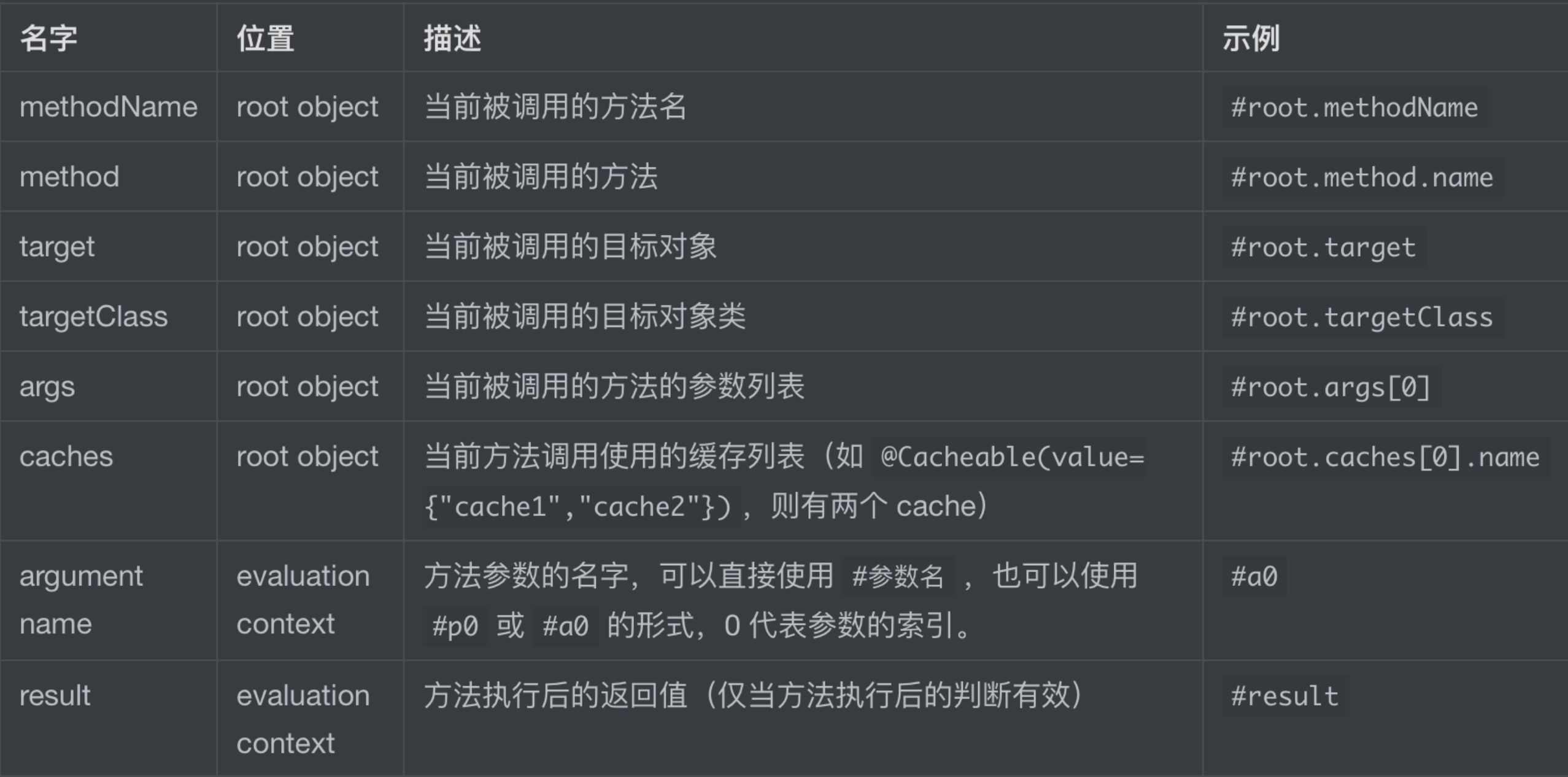7、@Cacheable 缓存注解
7、@Cacheable 缓存注解
一、简介
缓存介绍
缓存,在我们的日常开发中用的非常多,是我们应对各种性能问题支持高并发的一大利器。
Spring 从 3.1 开始就引入了缓存的支持。定义了如下两个接口来统一支持不同的缓存技术。
org.springframework.cache.Cache
org.springframework.cache.CacheManager我们熟知的缓存有:堆缓存(Ehcache3.x、Guava Cache、Caffeine 等)、堆外缓存(Ehcache3.x、MapDB 等)、分布式缓存(Redis、Memcached 等)等等。
常用的缓存注解:@EnableCaching、@Cacheable、@CachePut、@CacheEvict、
Cache 和 CacheManager 接口说明
- Cache 接口包含缓存的各种操作集合,你操作缓存就是通过这个接口来操作的。
- Cache 接口下 Spring 提供了各种 xxxCache 的实现,比如:RedisCache、EhCache、ConcurrentMapCache 等。
- CacheManager 定义了创建、配置、获取、管理和控制多个唯一命名的 Cache。这些 Cache 存在于 CacheManager 的上下文中。
二、缓存实战
1.开启缓存
在 SpringBoot 的启动类上添加注解@EnableCaching。
2.@Cacheable
@Cacheable的作用 主要针对方法配置,能够根据方法的请求参数对其结果进行缓存。
常用属性:
- cacheNames、value:用来指定缓存组件名称。
@Cacheable(cacheNames = "users", key="#id")
public User getUser(Integer id) {
}
- key:缓存数据的 key,可以用它来指定。默认使用所有参数的值进行组合。(key 可以使用 spEL 表达式来编写)。
@Cacheable(cacheNames = "usersBySpEL", key="#root.methodName + '[' + #id + ']'")
public User getUserBySpEL(Integer id) {
}
- keyGenerator:key 的生成器。key 和 keyGenerator 二选一使用。
@Cacheable(cacheNames = "userByKeyGenerator", keyGenerator = "myKeyGenerator")
public User getUserByKeyGenerator(Integer id) {
}
- condition:指定符合条件的情况下才缓存。
@Cacheable(cacheNames = "userByCondition", condition = "#id > 1")
public User getUserByCondition(Integer id) {
}
- unless:指定不符合条件的情况下才缓存。(可以获取到结果进行判断,通过 #result 获取方法结果,unless,汉语意思,除非,指会缓存,除了。。。之外)。
@Cacheable(cacheNames = "userByUnless", unless = "#id > 1")
public User getUserByUnless(Integer id) {
}
- sync:是否使用异步模式。
3.@CachePut
@CachePut的作用 主要针对配置,能够根据方法的请求参数对其结果进行缓存。
- 区别于 @Cacheable,它每次都会触发真实方法的调用,可以保证缓存的一致性。
- 属性与 @Cacheable 类同。
@CachePut(cacheNames = "users" , key = "#user.id")
public User addUser(User user) {
}
4.@CacheEvict
@CacheEvict的作用 主要针对方法配置,能够根据一定的条件对缓存进行清空。
常用属性
- cacheNames、value:用来指定缓存组件名称。
- key:缓存数据的 key,可以用它来指定。默认使用所有参数的值进行组合。(key 可以使用 spEL 表达式来编写)。
- condition:指定符合条件的情况下的缓存。
- allEntries:是否清空所有缓存,缺省为 false。
- beforeInvocation:是否在方法执行前就清空,缺省为 false,缺省情况下,如果方法执行抛异常,则不会清空缓存。
@CacheEvict(cacheNames = "users", key = "#id")
public void delUserCache(Integer id) {
}
5.@CacheConfig
@CacheConfig的作用 主要针对类配置,能够设置当前类中 @Cacheable 的 value 属性默认值。当然如果@Cacheable设置了 value,还是以设置的值为准。
常用属性
- cacheNames: 指定缓存名称默认值。
6.@Caching
@Caching的作用 主要针对方法配置,能够组合多个Cache注解。比如用户新增成功后,我们可能需要添加 id -> user、username -> user、email -> user 的缓存,此时就需要@Caching组合多个注解标签了。
常用属性
- cacheable:组合多个 @Cacheable 注解
- put:组合多个 @CachePut 注解
- evict:组合多个 @CacheEvict 注解
@CacheConfig(cacheNames = "users")
public class CacheTestServiceImpl implements CacheTestService {
/**
* @Cacheable 的 cacheNames 默认为 "users"
*/
@Cacheable(key="#id")
public User getUser(Integer id) {
...}
}
7.自定义缓存过期时间
7.1 设置全局默认缓存过期时间:
// 提供默认的cacheManager,应用于全局,实现存活2天
@Bean
@Primary
public CacheManager defaultCacheManager(
RedisTemplate<?, ?> redisTemplate) {
RedisCacheWriter writer = RedisCacheWriter.lockingRedisCacheWriter(redisTemplate.getConnectionFactory());
RedisCacheConfiguration config = RedisCacheConfiguration.defaultCacheConfig().entryTtl(Duration.ofDays(2));
return new RedisCacheManager(writer, config);
}
7.2 定制部分缓存过期时间
- 定制缓存过期时间,需要自定义 RedisCacheManager 来实现 ttl 设置。
- 注意:项目中如已配置了 RedisCacheManager 需要在原配置的 bean 上添加注解 @Primary,以免造成干扰
/**
自定义RedisCacheManager,用于在使用@Cacheable时设置ttl
*/
@Bean
public RedisCacheManager selfCacheManager(RedisTemplate<String, Object> redisTemplate) {
RedisCacheWriter redisCacheWriter = RedisCacheWriter.nonLockingRedisCacheWriter(redisTemplate.getConnectionFactory());
RedisCacheConfiguration redisCacheConfiguration = RedisCacheConfiguration.defaultCacheConfig()
.serializeValuesWith(RedisSerializationContext.SerializationPair.fromSerializer(redisTemplate.getValueSerializer()));
return new SelfRedisCacheManager(redisCacheWriter, redisCacheConfiguration);
}
SelfRedisCacheManager.java
public class SelfRedisCacheManager extends RedisCacheManager {
public SelfRedisCacheManager(RedisCacheWriter cacheWriter, RedisCacheConfiguration defaultCacheConfiguration) {
super(cacheWriter, defaultCacheConfiguration);
}
@Override
protected RedisCache createRedisCache(String name, RedisCacheConfiguration cacheConfig) {
String[] cells = StringUtils.delimitedListToStringArray(name, "=");
name = cells[0];
if (cells.length > 1) {
long ttl = Long.parseLong(cells[1]);
// 根据传参设置缓存失效时间,默认单位是秒
cacheConfig = cacheConfig.entryTtl(Duration.ofSeconds(ttl));
}
return super.createRedisCache(name, cacheConfig);
}
}
使用:
// value、cacheNames是等效的,ttl=600s,unless是不缓存的结果(为null时不缓存)
@Cacheable(value = "p_user=600",key = "#menu+'_'+#type+'_'+#userId",cacheManager = "selfCacheManager", unless = "#result == null")
public User getUser(...){
xxx
}
// 当前方法执行时对应的key失效,也可以用@CachePut在当前方法执行时更新key
@CacheEvict(cacheNames = "p_user",key = "#p.menu+'_'+#p.type+'_'+#p.user")
public boolean setUser(User p){
xxx
}
三、spEL 表达式

参考地址:
1、 @Cacheable 设置过期时间:https://blog.csdn.net/weixin_41860719/article/details/125226096;
整理完毕,完结撒花~ 🌻
